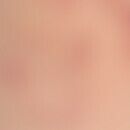Synonym(s)
Bearded Syndrome; Epidermolysis and congenital absence of skin; Epidermolysis bullosa dystrophica Beard; Epidermolysis bullosa dystrophica localisata
HistoryThis section has been translated automatically.
Bart, 1966
DefinitionThis section has been translated automatically.
Combination of a non-scarring form from the epidermolysis bullosa group with congenital epidermal defects and nail aplasia or deformities.
You might also be interested in
EtiopathogenesisThis section has been translated automatically.
Probably autosomal dominant inheritance. Sporadic occurrence has been described.
ManifestationThis section has been translated automatically.
In the first months of life.
ClinicThis section has been translated automatically.
Circumscribed skin defects ( Aplasia cutis congenita), usually on a lower extremity in the form of one or more red, shiny, erosive plaques. Continuous formation to lenticular-sized blisters filled with clear fluid, especially on the hands and feet, the oral mucosa and perioral. These heal without scarring or with delicate atrophy, occasionally milia formation. Nail deformities (aplasia or onychodystrophy) especially on the thumb and big toe nails.
HistologyThis section has been translated automatically.
Blistering due to epidermal fissure formation above the basement membrane.
Differential diagnosisThis section has been translated automatically.
Other forms of the Epidermolysis bullosa group.
TherapyThis section has been translated automatically.
- Symptomatic: Opening of the blisters, antiseptic lotion like 0,5% Clioquinol lotio/ointment( R050, Linola-Sept) or solutions like polihexanide (Serasept, Prontoderm), quinolinol solution(e.g. Chinosol 1:1000), R042 or potassium permanganate solution(light pink).
- No aggressive therapy, as blistering continuously decreases and disappears within the first years of life. Avoidance of mechanical irritations and pressure points on the skin, diet rich in vitamins and minerals.
Progression/forecastThis section has been translated automatically.
Favourable: The tendency to blistering decreases continuously during the first years of life and finally disappears.
LiteratureThis section has been translated automatically.
- Bart BJ et al (1966) Congenital localized absence of skin and associated abnormalities resembling epidermolysis bullosa. A new syndrome. Arch Dermatol 93: 296-304
- Christiano AM, Bart BJ et al (1996) Genetic basis of Bart's syndrome: a glycine substitution mutation in the type VII collagen gene. J Invest Dermatol 106: 1340-1342
- Duran-McKinster C et al (2001) Bart syndrome: the congenital localized absence of skin may follow the lines of Blaschko. Report of six cases. Pediatric dermatol 17: 179-182
- Gutzmer R (1997) Bart syndrome--separate entity or a variant of epidermolysis bullosa? dermatologist 48: 640-644
- Puvabanditsin S et al (2001) Junctional epidermolysis bullosa associated with congenital localized absence of skin, and pyloric atresia in two newborn siblings. J Am Acad Dermatol 44: S330-335
- Voß M (1985) Epidermolysis bullosa dystrophica beard (beard syndrome). dermatologist 36: 351-353
- Wakasugi S et al (1998) Clinical phenotype of Bart's syndrome seen in a family with dominant dystrophic epidermolysis bullosa. J Dermatol 25: 517-522
Incoming links (3)
Bearded syndrome; Clioquinol lotio 0.5-5%; Quinolinol sulphate monohydrate solution 0,1 % (nrf 11.127.);Outgoing links (8)
Aplasia cutis congenita (overview); Clioquinol; Clioquinol lotio 0.5-5%; Epidermolysis bullosa hereditaria (overview); Milia; Onychodystrophy (overview); Polihexanide; Potassium permanganate;Disclaimer
Please ask your physician for a reliable diagnosis. This website is only meant as a reference.




